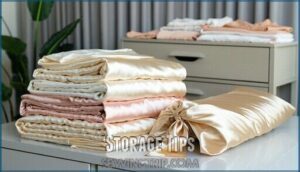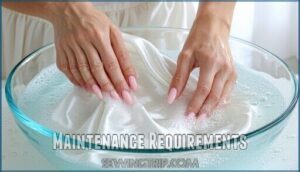This site is supported by our readers. We may earn a commission, at no cost to you, if you purchase through links.

Satin’s smooth, slippery surface doesn’t trap heat like cotton or flannel. Instead, it glides against your skin with a silky sensation that stays invigoratingly cool.
The fabric’s tight weave creates that signature glossy finish, but it won’t make you feel toasty on chilly nights. Think of it like sleeping on a gentle breeze rather than a warm hug.
Synthetic satins tend to feel cooler than natural silk versions, which offer better temperature balance. The choice between warmth and that luxurious cool touch depends on your specific comfort needs.
Table Of Contents
Key Takeaways
- You’ll discover satin actually feels cool to the touch, not warm – its smooth weave doesn’t trap heat like cotton or flannel, creating a refreshing sensation against your skin
- You won’t get the cozy warmth you’re expecting from satin sheets or pajamas since synthetic versions trap heat without providing insulation, making them less ideal for cold sleepers
- You’ll find satin’s temperature adapts to your body heat over time, starting cool but gradually warming up through contact, though it never becomes truly warm like natural insulating fabrics
- You’ll need to layer satin with other materials if you want actual warmth – the fabric works better as a smooth, cooling base layer rather than a standalone warming solution
What is Satin Fabric
You’ve probably felt satin’s smooth, silky surface without realizing it’s actually a weave pattern, not a specific material like cotton or wool.
This luxurious fabric can be made from silk, polyester, nylon, or rayon, which explains why some satin feels expensive while other versions cost much less, highlighting the impact of material on the overall feel and luxurious quality.
Smooth Texture
Satin’s smoothness creates an instant connection between fabric and skin.
You’ll notice the gentle glide as your fingers move across its surface, delivering a luxurious touch that feels like liquid silk.
This tactile sensation comes from satin’s distinctive weave pattern.
Here’s what makes satin texture so appealing:
- Silky sensation – No rough edges or bumps interrupt the flow
- Delicate feel – Light pressure reveals its softness factor
- Pleasant feel – Cool, smooth material glides effortlessly
- Warm fabric feel – Adapts to your body temperature naturally
Synthetic Composition
Understanding the smooth texture you’ve just experienced, you’ll find that modern satin’s synthetic composition creates this luxurious feel through clever manufacturing.
Most satin fabrics use polyester layers, nylon alternatives, or acetate usage to mimic silk’s properties at lower production costs.
These blend variations give you that soft satin experience while keeping the warm fabric feel affordable and accessible.
| Material Type | Cost Level | Texture Quality | Durability |
|---|---|---|---|
| Polyester Satin | Low | Smooth Material | High |
| Nylon Satin | Medium | Comfortable Satin | Medium |
| Acetate Satin | Medium | Satin Texture | Low |
| Blended Satin | Variable | Balanced Feel | Medium |
Weave Style
Beyond its synthetic makeup, you’ll discover that satin’s distinctive weave style creates its signature feel.
The tight weave pattern produces that smooth, glossy surface you recognize instantly. This weaving technique determines how the fabric drapes and moves against your skin.
- Satin Weave Types include charmeuse, duchess, and crepe-back varieties
- Weave Tightness affects durability and determines the fabric’s luxurious texture
- Thread Count influences softness levels and overall weave quality
What Does Satin Feel Like
When you run your fingers across satin, you’re experiencing one of the most distinctive sensory experiences in textiles.
Satin’s smooth surface delivers an instant sensory rush that transforms ordinary touch into pure luxury.
The fabric’s signature smooth glide feels like sliding your hand across silk-covered ice.
This sensual fabric delivers an immediate cool essence that surprises first-time users – it’s genuinely cool to the touch, not warm like cotton or wool.
Satin’s texture creates an almost otherworldly sensation.
The luxurious softness comes from its unique weave pattern, which polishes individual fibers into submission.
You’ll notice how the fabric seems to flow around your skin rather than grip it.
This inviting texture makes satin feel more like liquid than solid material.
The gentle warmth develops only after prolonged contact with your body heat.
Initially, satin maintains its signature coolness, creating an invigorating contrast against warm skin.
Whether you’re touching satin sheets or wearing satin pajamas, that first contact delivers an unmistakable "ahh" moment – cool, smooth, and utterly luxurious.
Satin Fabric Characteristics
You’ll notice satin’s unique characteristics when you first touch its smooth, glossy surface and feel its naturally cool temperature against your skin.
The fabric’s special weave pattern creates a breathable material that reflects light on one side while maintaining a dull finish on the back, giving you both visual appeal and practical comfort.
Cool to Touch
When you first touch satin, you’ll notice its distinctive coolness against your skin.
This Satin Coolness comes from the fabric’s unique weave structure that conducts heat away from your body.
The smooth texture creates immediate sensory perception of freshness, making it feel invigoratingly cool even at room temperature.
This cool sensation enhances Summer Comfort, though the fabric’s actual warmth retention varies by fiber composition.
Breathable Weave
Satin’s weave structure directly impacts its breathability and temperature regulation.
The tight weave pattern creates limited weave airflow, making synthetic alternatives less breathable than natural satins. Fiber density plays a pivotal role in how this warm textile performs.
- Natural satins like silk offer better breathability than polyester versions
- Weave innovation affects how air circulates through the fabric layers
- Cool nights benefit from satin’s unique weave characteristics
Glossy Surface
You’ll notice satin’s signature shiny appearance comes from its unique light reflection properties.
The glossy surface creates stunning visual appeal, making fabric drape beautifully across your skin.
This surface smoothness enhances satin’s aesthetic qualities, giving it that luxurious touch you’d expect.
While the fabric temperature feels cool initially, the shiny finish adds warmth to any room’s ambiance.
Satin Vs Silk Comparison
You’ll notice satin and silk feel quite different when you touch them, even though people often mix them up.
Satin is a weave pattern that can use synthetic materials like polyester, while silk comes from silkworm cocoons and offers superior breathability and natural temperature regulation.
Natural Fibers
Understanding fabric origins helps you make smarter bedding choices.
Silk production creates natural fibers from silkworm cocoons, while satin typically uses synthetic materials.
You’ll find cotton satin and rayon benefits offer middle-ground options between pure silk’s luxurious touch and polyester’s affordability.
Natural fiber options like modal properties provide breathability that synthetic satin can’t match.
| Fabric Type | Source | Feel |
|---|---|---|
| Pure Silk | Silkworm cocoons | Naturally smooth, warm to touch |
| Cotton Satin | Cotton plants | Soft, breathable natural fiber |
| Rayon Satin | Wood pulp | Silk-like, cool sensation |
| Polyester Satin | Synthetic chemicals | Slippery, less breathable |
| Linen Alternatives | Flax plants | Crisp, naturally cooling |
Durability
When comparing fabric durability, you’ll find significant differences between these luxurious materials.
Silk’s natural strength creates lasting quality, while satin’s synthetic composition affects longevity differently.
| Durability Factor | Silk | Satin |
|---|---|---|
| Weave Strength | High natural fiber resilience | Variable based on synthetic blend |
| Snag Resistance | Moderate, requires gentle handling | Lower, prone to pulls and tears |
| Pilling Potential | Minimal with proper long-term care | Higher risk with synthetic fibers |
Understanding fiber quality helps you choose wisely for lasting comfort.
The key to making an informed decision lies in recognizing the durability differences and considering the longevity of each material.
Breathability
Beyond fabric strength lies another critical factor in your comfort equation.
Silk’s natural fiber structure creates superior air permeability, allowing your body temperature to stay regulated throughout the night.
You’ll find silk effectively wicks moisture away from your skin, while synthetic satin traps heat and becomes less breathable due to its tight weave density.
| Feature | Silk | Satin |
|---|---|---|
| Air Flow | High permeability | Limited airflow |
| Moisture Management | Natural wicking | Non-absorbent |
| Fiber Type | Natural protein | Synthetic polymer |
| Heat Retention | Temperature regulating | Traps body heat |
| Summer Comfort | Cool and breathable | Can feel warm |
The key differences between silk and satin, such as natural fiber structure, moisture management, and heat retention, significantly impact the comfort level of the wearer, making silk a preferable choice for temperature regulating and overall comfort.
Is Satin a Warm Fabric
You’ll find that satin isn’t actually a warm fabric since its tight weave structure doesn’t trap much air for insulation.
This smooth material acts more like a temperature chameleon, staying cool against your skin in summer while adapting to your body heat during cooler months, making it a versatile choice due to its ability to mimic the body heat.
Temperature Regulation
Satin works as a temperature regulator through its unique fiber density and weave structure.
You’ll experience cool initial contact, but satin’s isothermal properties adapt to your body heat.
The fabric’s moisture wicking capabilities help maintain comfort, though satin breathability varies by material composition.
This dual nature makes satin respond differently to warmth based on environmental conditions and your body temperature.
Seasonal Use
You’ll find satin works best during specific seasons based on your climate needs.
Spring and fall offer ideal conditions for satin’s dual nature – cool enough to appreciate its smoothness without overheating.
Summer brings challenges with synthetic versions trapping heat, while winter allows comfortable satin layering.
Natural fiber breathability determines seasonal comfort more than synthetic alternatives for year-round weather adaptation.
Moisture Absorption
Understanding satin’s moisture absorption reveals why comfort varies so dramatically.
As a synthetic material, satin doesn’t absorb moisture like natural fibers, instead, it repels sweat and oils, leaving you feeling damp in humid climates.
This poor breathability affects your comfort level substantially.
While synthetic alternatives offer affordability, they lack the moisture-wicking properties that keep you dry and comfortable throughout the night, which is a critical factor in overall comfort.
Satin Sheets in Summer
You’ll find satin sheets feel cool against your skin initially, but their synthetic fibers trap heat and moisture as the night progresses.
This makes them less than ideal for hot summer nights when you need breathable bedding that wicks away sweat and allows airflow.
Cool Nights
Hot summer evenings call for fabrics that won’t leave you tossing and turning.
Satin’s smooth, cool surface provides initial relief against your skin, creating that luxurious nighttime bliss you’re craving. The coolness factor makes satin an appealing choice for summer sleep comfort.
Many consumers purchase satin summer sheets for their bedding needs.
- Initial contact feels invigoratingly cool against warm skin
- Smooth texture glides effortlessly without catching or pulling
- Lightweight feel won’t weigh you down during hot nights
Breathability Issues
Polyester-based satin creates breathability problems that’ll leave you feeling sticky.
The tight weave and fiber density block air circulation, turning your bed into a sweat trap.
Unlike moisture-wicking fabrics, nonbreathable satin holds heat retention close to your skin.
Many seek solutions for satin sheets breathability.
You’ll wake up with sweat stains during hot weather, making peaceful sleep nearly impossible.
Synthetic Fibers
Most satin sheets contain synthetic fibers that dramatically affect summer comfort.
Polyester properties create a non-breathable barrier that traps heat against your skin, while nylon benefits include durability but poor ventilation.
For options related to microfiber satin heat, explore online resources.
Consider these synthetic options:
- Microfiber satin – traps more heat than traditional weaves
- Acetate qualities – slightly more breathable than polyester
- Synthetic blends – combine rayon with other fibers for better airflow
Satin Pajamas Warmth
You’ll find satin pajamas slip and slide more than regular sleepwear due to their smooth, glossy surface.
They work best in cooler weather when you can layer them with a robe or blanket for extra warmth.
Slippery Texture
When you slip into satin pajamas, you’ll notice they glide against your skin like silk ribbons.
This slippery texture creates bedding movement as you shift during sleep, with clothing cling becoming minimal due to friction reduction.
The smooth, luxurious feel means handling difficulty increases when adjusting covers, but satin slippage helps maintain that warm, cozy sensation without fabric bunching.
Cool Weather
During chilly nights, you’ll find satin pajamas surprisingly effective at winter warmth.
Cold sleepers appreciate how this heated fabric traps body heat against your skin. However, static electricity can become bothersome in dry conditions.
Here’s what affects satin warmth:
- Heat retention increases with synthetic fibers
- Satin layering works well over base garments
- Fabric weight determines insulation levels
- Room humidity impacts static buildup
Layering Options
When winter winds howl, you can transform lightweight satin pajamas into cozy warmth through smart fabric combinations.
Layer cotton or flannel underneath for heated fabric comfort, or add wool socks and a soft robe.
Blanket choices matter too—pair your satin sleepwear with fleece throws or down comforters.
These seasonal layers create the perfect balance between satin’s smooth texture and winter’s bite, using smart fabric combinations to achieve cozy warmth.
Satin for Cold Sleepers
If you’re someone who gets cold at night, satin’s tight weave actually traps your body heat close to your skin, creating a cozy barrier that keeps you warmer than you’d expect.
You’ll find that synthetic satin sheets work especially well for cold sleepers since they don’t breathe much, which means less heat escapes while you sleep, making them a good choice for cold sleepers.
Trapping Body Heat
Your body heat gets trapped between satin’s tightly woven fibers, creating a cozy cocoon effect.
The fabric’s fiber density and weave tightness work like a heated textile blanket, holding warmth close to your skin.
However, layering effects can increase discomfort levels if you’re naturally warm.
This insulation makes satin perfect for cold sleepers seeking heat retention.
Insulation Properties
Satin’s insulation properties depend on fiber density and weave tightness working together like a thermal blanket.
Dense polyester satin creates better heat retention than loose silk weaves, while the tight construction traps warm air close to your skin.
This heated textile effect makes satin surprisingly effective for thermal regulation when you’re seeking cozy comfort during cooler nights, utilizing its properties for better heat retention.
Natural Fiber Options
When your body craves warmth, natural fiber options deliver superior comfort.
Silk satin offers exceptional temperature regulation while cotton satin provides breathable luxury.
Modal properties include moisture-wicking abilities that synthetic versions can’t match.
These silk fibers create silk fabrics with a genuinely luxurious feel.
Rayon benefits include softness without the plastic-like texture, making linen alternative choices perfect for cold sleepers.
Satin Fabric Care
You’ll need to handle your satin fabrics with extra care since they’re more delicate than regular cotton materials.
Proper cleaning and storage methods will keep your satin sheets, pajamas, and clothing looking smooth and feeling luxurious for years to come.
Cleaning Methods
Gentle handwashing satin beats machine washing every time.
Use cold water and mild detergent for fabric care without damage.
For stubborn stains, spot-treat before laundering rather than scrubbing harshly.
Skip the dryer—air-dry flat to prevent wrinkles.
When ironing satin, use low heat with a pressing cloth.
Professional cleaning works best for expensive pieces requiring special maintenance and expert drying techniques.
Storage Tips
Three simple folding techniques protect your satin fabric from creases and wrinkles.
Store pieces flat in breathable cotton bags for ideal humidity control and moth prevention.
Choose cedar-lined drawers or acid-free boxes for space optimization while maintaining proper airflow.
Keep storage areas cool and dry to prevent moisture damage.
Tissue paper between folds provides extra stain protection during long-term maintenance periods, and proper storage helps maintain the fabric’s quality over time, considering the importance of breathable materials.
Maintenance Requirements
Beyond proper storage, your satin needs regular upkeep to maintain its luxurious feel.
Hand wash delicate pieces in cool water, while machine wash on gentle cycles works for sturdier items.
Skip the dryer—air drying prevents heat damage.
For stubborn stains, blot gently rather than rubbing.
When ironing satin, use low heat with a pressing cloth to protect the glossy surface.
Choosing Satin or Silk
You’ll find yourself weighing luxury against practicality when choosing between satin and silk fabrics.
Satin offers an affordable way to enjoy smooth, glossy textures, while silk provides natural temperature regulation and superior breathability that your skin and hair will appreciate, making it a choice that balances practicality.
Luxury Feel
Both fabrics deliver luxurious feel, but they’re not created equal.
Satin’s silky smoothness comes from its elegant drape and high threadcount weave, creating visual appeal that catches the eye.
You’ll notice the sensual touch immediately – that smooth, almost liquid sensation against your skin.
While synthetic satin offers cozy satin comfort at budget-friendly prices, silk provides the ultimate soothing satin experience.
The luxurious reputation isn’t just marketing hype; it’s about how these fabrics make you feel pampered and sophisticated.
Skin and Hair Benefits
While luxury matters, your skin and hair deserve the best protection possible.
Silk’s gentle texture offers superior skin benefits through reduced friction against delicate facial skin. You’ll notice less breakage prevention for your hair since silk maintains hydration retention better than synthetic satin.
The smooth surface provides excellent skin protection while minimizing irritation during sleep. Silk’s natural properties also support allergy reduction, making it ideal for sensitive skin types seeking comfort, with benefits including superior skin benefits and hydration retention.
Frequently Asked Questions (FAQs)
Is satin a warm fabric?
Like a cool breeze on summer skin, satin isn’t warm at all.
You’ll find it stays invigoratingly cool against your body, making it perfect for hot nights but less cozy during chilly winter evenings.
Why does satin feel good?
Satin feels good because its smooth, silky texture glides effortlessly across your skin without any rough edges.
The cool, luxurious fabric creates a feminine sensation that’s both comfortable and elegant against your body.
Why does satin feel hot?
Like a heat trap, you’ll find synthetic satin fabrics feel hot because their tight weave blocks airflow and traps body heat against your skin.
Preventing natural cooling and moisture evaporation during sleep.
Does satin have a smooth feel?
Yes, you’ll find satin incredibly smooth to touch.
Its distinctive weave creates a silky, glide-like surface that feels luxurious against your skin.
There’s no roughness or texture—just pure, buttery smoothness that’s instantly recognizable.
Is satin a hot fabric?
No, satin isn’t considered a hot fabric.
You’ll find it stays relatively cool against your skin due to its smooth weave.
However, synthetic satin versions can trap some heat, making them less breathable than natural alternatives.
Does satin have a similar feel to silk?
About 90% of satin fabrics mimic silk’s smoothness through synthetic weaving.
You’ll notice satin feels similarly luxurious and slippery, but it lacks genuine silk’s natural breathability and temperature-regulating properties that make it superior.
Does it feel hot in satin?
You might feel warm in satin because it traps body heat against your skin. The tight weave doesn’t breathe well, making it less ideal for hot sleepers or humid nights.
Is satin warm to wear?
You’ll find satin isn’t particularly warm – it’s actually quite cool against your skin.
The fabric’s tight weave traps some heat but doesn’t provide much insulation, making it better for mild weather than cold nights.
What is satin supposed to feel like?
Smooth and silky against your skin, satin glides like cool water.
You’ll notice its glossy surface feels luxurious yet slippery.
The fabric’s tight weave creates a soft, supple texture that’s immediately comfortable without any break-in period needed.
How much more expensive is satin compared to cotton sheets?
You’ll typically pay 20-50% more for satin sheets than basic cotton ones.
Quality cotton percale runs $50-150, while comparable satin ranges $75-
However, synthetic satin can actually cost less than premium cotton options.
Conclusion
Ironically, when asking what does satin feel like warm, you’ll find it’s anything but cozy.
This fabric’s smooth weave naturally resists heat retention, making it perfect for hot sleepers but challenging for those seeking winter warmth.
Your choice between satin and silk ultimately depends on whether you prefer that cool, slippery sensation or need better temperature regulation.
Consider your sleeping preferences, climate, and budget when deciding which luxurious fabric suits your comfort needs best.



















